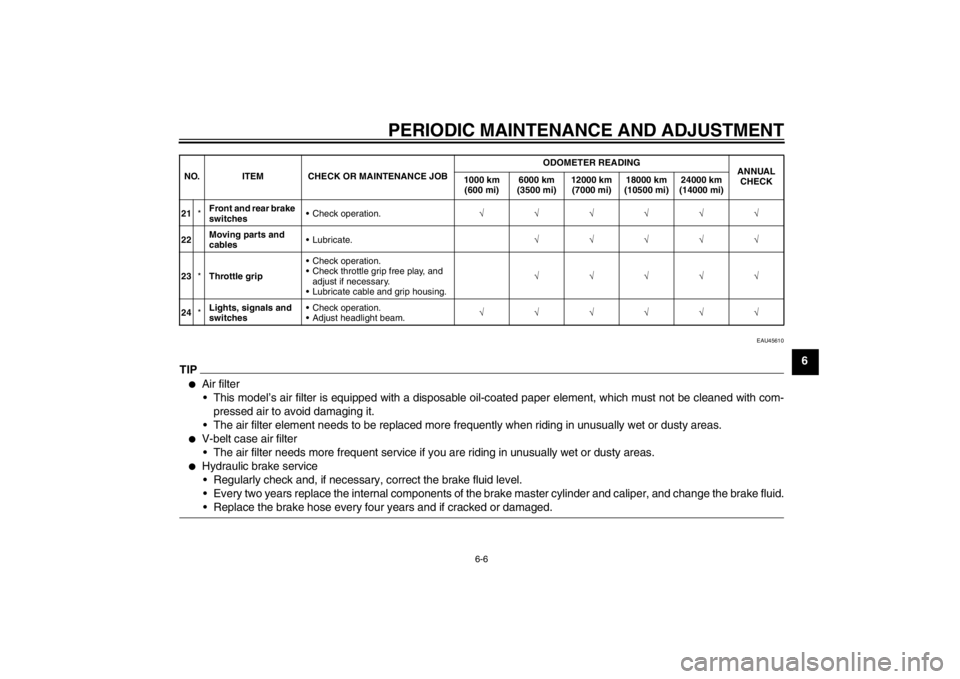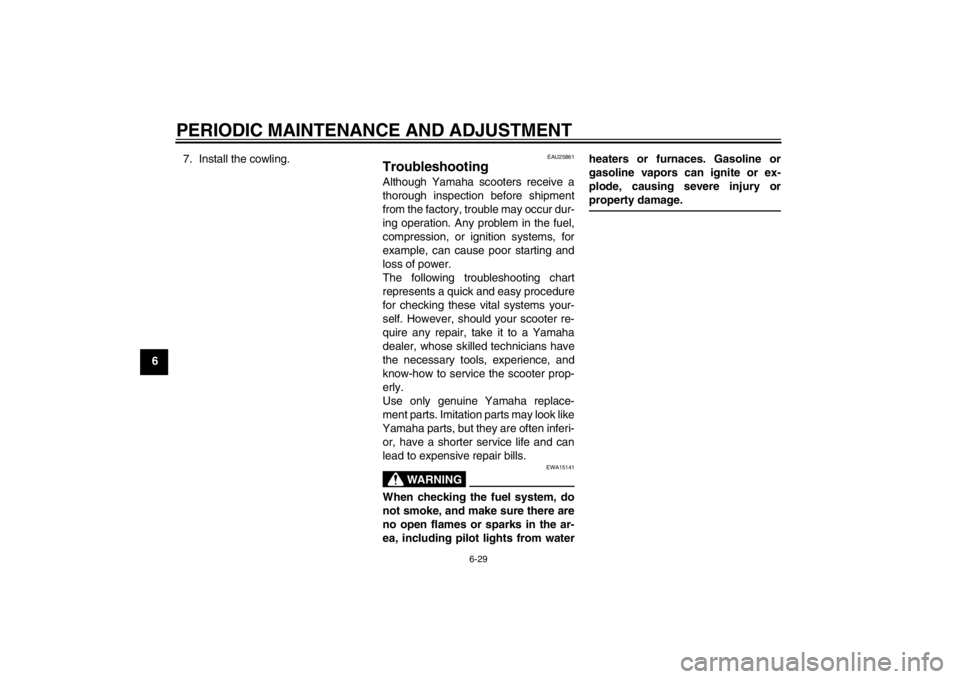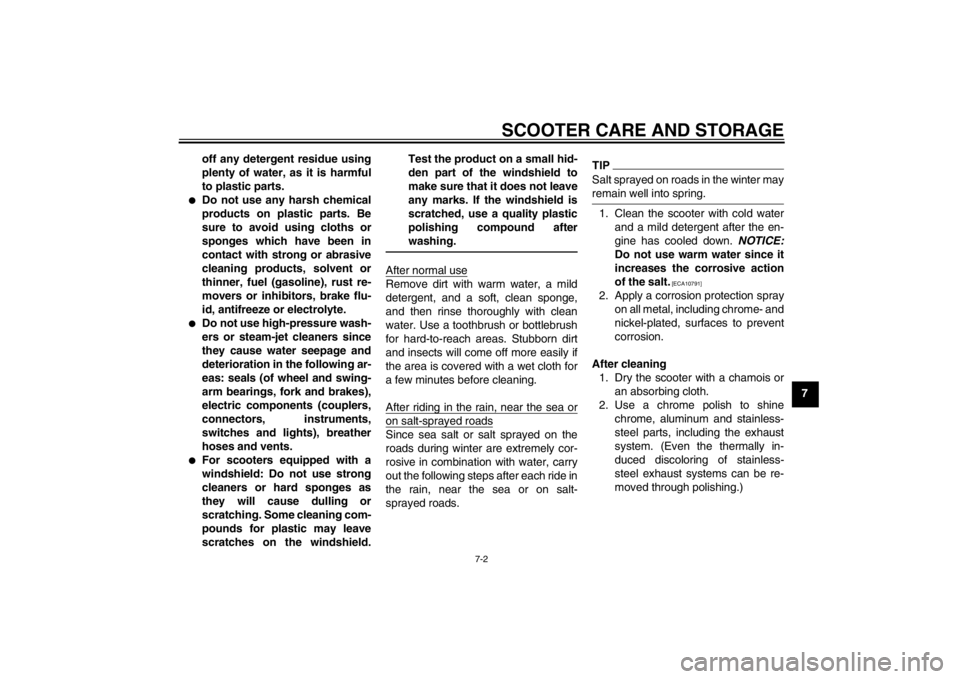lights YAMAHA CYGNUS L 2012 Owners Manual
[x] Cancel search | Manufacturer: YAMAHA, Model Year: 2012, Model line: CYGNUS L, Model: YAMAHA CYGNUS L 2012Pages: 76, PDF Size: 1.56 MB
Page 6 of 76

TABLE OF CONTENTSSAFETY INFORMATION ..................1-1
Further safe-riding points ................1-5
DESCRIPTION ..................................2-1
Left view ..........................................2-1
Right view ........................................2-2
Controls and instruments.................2-3
INSTRUMENT AND CONTROL
FUNCTIONS.......................................3-1
Main switch/steering lock ................3-1
Keyhole cover .................................3-2
Indicator lights and warning light ....3-2
Speedometer unit ...........................3-3
Self-diagnosis device ......................3-3
Fuel gauge ......................................3-4
Handlebar switches ........................3-4
Front brake lever ............................3-5
Rear brake lever .............................3-5
Fuel tank cap ..................................3-5
Fuel .................................................3-6
Catalytic converters ........................3-7
Kickstarter .......................................3-8
Seat ................................................3-8
Helmet holders ...............................3-9
Storage compartments ...................3-9
Carrier ...........................................3-11
Luggage hook ...............................3-11
Grab bar .......................................3-11
Sidestand ......................................3-12
Ignition circuit cut-off system ........3-12FOR YOUR SAFETY –
PRE-OPERATION CHECKS............. 4-1
OPERATION AND IMPORTANT
RIDING POINTS................................. 5-1
Starting the engine ......................... 5-1
Starting off ...................................... 5-2
Acceleration and deceleration ........ 5-2
Braking ........................................... 5-2
Tips for reducing fuel
consumption ............................... 5-3
Engine break-in .............................. 5-3
Parking ........................................... 5-4
PERIODIC MAINTENANCE AND
ADJUSTMENT................................... 6-1
Periodic maintenance chart for
the emission control system ....... 6-3
General maintenance and
lubrication chart .......................... 6-4
Removing and installing cowlings
and panels .................................. 6-7
Checking the spark plug ................. 6-9
Engine oil ..................................... 6-10
Final transmission oil .................... 6-12
Air filter and V-belt case air filter
elements ................................... 6-13
Checking the engine idling
speed ........................................ 6-15
Checking the throttle grip free
play ........................................... 6-15Valve clearance ........................... 6-15
Tires ............................................. 6-16
Cast wheels ................................. 6-17
Checking the front brake lever
free play .................................... 6-18
Adjusting the rear brake lever
free play .................................... 6-18
Checking the front brake pads
and rear brake shoes ............... 6-19
Checking the brake fluid level ...... 6-20
Changing the brake fluid .............. 6-21
Checking and lubricating
the cables ................................. 6-21
Checking and lubricating
the throttle grip and cable ......... 6-21
Lubricating the front and
rear brake levers ...................... 6-22
Checking and lubricating the
centerstand and sidestand ....... 6-22
Checking the front fork ................. 6-23
Checking the steering .................. 6-24
Checking the wheel bearings ....... 6-24
Battery ......................................... 6-24
Replacing the fuse ....................... 6-26
Replacing the headlight bulb ....... 6-26
Replacing a front turn signal
light bulb ................................... 6-27
Rear turn signal light and
tail/brake light ........................... 6-28
Replacing the auxiliary light
bulb ........................................... 6-28U1RSE0E0.book Page 1 Tuesday, October 18, 2011 8:56 AM
Page 11 of 76

SAFETY INFORMATION
1-4
1 Aftermarket Parts, Accessories, and
Modifications
While you may find aftermarket prod-
ucts similar in design and quality to
genuine Yamaha accessories, recog-
nize that some aftermarket accessories
or modifications are not suitable be-
cause of potential safety hazards to you
or others. Installing aftermarket prod-
ucts or having other modifications per-
formed to your vehicle that change any
of the vehicle’s design or operation
characteristics can put you and others
at greater risk of serious injury or death.
You are responsible for injuries related
to changes in the vehicle.
Keep the following guidelines in mind,
as well as those provided under “Load-
ing” when mounting accessories.
●
Never install accessories or carry
cargo that would impair the perfor-
mance of your scooter. Carefully
inspect the accessory before using
it to make sure that it does not in
any way reduce ground clearance
or cornering clearance, limit sus-pension travel, steering travel or
control operation, or obscure lights
or reflectors.
Accessories fitted to the handle-
bar or the front fork area can
create instability due to improper
weight distribution or aerody-
namic changes. If accessories
are added to the handlebar or
front fork area, they must be as
lightweight as possible and
should be kept to a minimum.
Bulky or large accessories may
seriously affect the stability of
the scooter due to aerodynamic
effects. Wind may attempt to lift
the scooter, or the scooter may
become unstable in cross
winds. These accessories may
also cause instability when
passing or being passed by
large vehicles.
Certain accessories can dis-
place the operator from his or
her normal riding position. This
improper position limits the free-
dom of movement of the opera-tor and may limit control ability,
therefore, such accessories are
not recommended.
●
Use caution when adding electri-
cal accessories. If electrical acces-
sories exceed the capacity of the
scooter’s electrical system, an
electric failure could result, which
could cause a dangerous loss of
lights or engine power.
Aftermarket Tires and Rims
The tires and rims that came with your
scooter were designed to match the
performance capabilities and to provide
the best combination of handling, brak-
ing, and comfort. Other tires, rims, siz-
es, and combinations may not be
appropriate. Refer to page 6-16 for tire
specifications and more information on
replacing your tires.
Transporting the Scooter
Be sure to observe following instruc-
tions before transporting the scooter in
another vehicle.
●
Remove all loose items from the
scooter.
U1RSE0E0.book Page 4 Tuesday, October 18, 2011 8:56 AM
Page 18 of 76

INSTRUMENT AND CONTROL FUNCTIONS
3-2
3To unlock the steering and the center-
standPush the key in, and then turn it to
“OFF” while still pushing it.
EAUT2121
Keyhole cover To close the keyhole cover
Insert the key bow into the keyhole cov-
er receptacle as shown, and then turn
the key to “SHUT” to close the cover.
To open the keyhole cover
Insert the key bow into the keyhole cov-
er receptacle as shown, and then turn
the key to “OPEN” to open the cover.
EAU11006
Indicator lights and warning
light
EAU11020
Turn signal indicator light “ ”
This indicator light flashes when the
turn signal switch is pushed to the left or
right.
EAU11080
High beam indicator light “ ”
This indicator light comes on when the
high beam of the headlight is switched
on.
1. Push.
2. Turn.12
ON
OPEN
OPENPUSH
LOCK
OFF
1. Engine trouble warning light “ ”
2. High beam indicator light “ ”
3. Turn signal indicator light “ ”
123
U1RSE0E0.book Page 2 Tuesday, October 18, 2011 8:56 AM
Page 20 of 76

INSTRUMENT AND CONTROL FUNCTIONS
3-4
3
EAU45630
Fuel gauge The fuel gauge indicates the amount of
fuel in the fuel tank. The needle moves
towards “E” (Empty) as the fuel level
decreases. When the needle reaches
the red line, refuel as soon as possible.TIPTurning the key to “OFF” cancels the
fuel gauge reading.
EAU1234A
Handlebar switches Left
Right
EAU12400
Dimmer switch “ / ”
Set this switch to “ ” for the high
beam and to “ ” for the low beam.
EAU12460
Turn signal switch “ / ”
To signal a right-hand turn, push this
switch to “ ”. To signal a left-hand
turn, push this switch to “ ”. When re-
leased, the switch returns to the center
position. To cancel the turn signal
lights, push the switch in after it has re-
turned to the center position.
EAU12500
Horn switch “ ”
Press this switch to sound the horn.
EAU12721
Start switch “ ”
With the sidestand up, push this switch
while applying the front or rear brake to
crank the engine with the starter. See
page 5-1 for starting instructions prior
to starting the engine.
1. Fuel gauge
2. Red line
1
2
1. Dimmer switch “ / ”
2. Turn signal switch “ / ”
3. Horn switch “ ”
1. Start switch “ ”
2 13
1
U1RSE0E0.book Page 4 Tuesday, October 18, 2011 8:56 AM
Page 22 of 76

INSTRUMENT AND CONTROL FUNCTIONS
3-6
3
WARNING
EWA11091
Make sure that the fuel tank cap is
properly closed after filling fuel.
Leaking fuel is a fire hazard.
EAU13221
Fuel Make sure there is sufficient gasoline in
the tank.
WARNING
EWA10881
Gasoline and gasoline vapors are
extremely flammable. To avoid fires
and explosions and to reduce the
risk of injury when refueling, follow
these instructions.1. Before refueling, turn off the en-
gine and be sure that no one is sit-
ting on the vehicle. Never refuel
while smoking, or while in the vi-
cinity of sparks, open flames, or
other sources of ignition such as
the pilot lights of water heaters and
clothes dryers.
2. Do not overfill the fuel tank. When
refueling, be sure to insert the
pump nozzle into the fuel tank filler
hole. Stop filling when the fuel
reaches the bottom of the filler
tube. Because fuel expands when
it heats up, heat from the engine or
the sun can cause fuel to spill out
of the fuel tank.3. Wipe up any spilled fuel immedi-
ately. NOTICE: Immediately wipe
off spilled fuel with a clean, dry,
soft cloth, since fuel may deteri-
orate painted surfaces or plastic
parts.
[ECA10071]
4. Be sure to securely close the fuel
tank cap.
WARNING
EWA15151
Gasoline is poisonous and can
cause injury or death. Handle gaso-
line with care. Never siphon gaso-
line by mouth. If you should swallow
some gasoline or inhale a lot of gas-
oline vapor, or get some gasoline in
your eyes, see your doctor immedi-1. Fuel tank filler tube
2. Maximum fuel level
2 1
U1RSE0E0.book Page 6 Tuesday, October 18, 2011 8:56 AM
Page 31 of 76

FOR YOUR SAFETY – PRE-OPERATION CHECKS
4-2
4
Throttle grip Make sure that operation is smooth.
Check throttle grip free play.
If necessary, have Yamaha dealer adjust throttle grip free play and lubricate cable
and grip housing.6-15, 6-21
Control cables Make sure that operation is smooth.
Lubricate if necessary.6-21
Wheels and tires Check for damage.
Check tire condition and tread depth.
Check air pressure.
Correct if necessary.6-16, 6-17
Brake levers Make sure that operation is smooth.
Lubricate lever pivoting points if necessary.6-22
Centerstand, sidestand Make sure that operation is smooth.
Lubricate pivots if necessary.6-22
Chassis fasteners Make sure that all nuts, bolts and screws are properly tightened.
Tighten if necessary.—
Instruments, lights, signals
and switches Check operation.
Correct if necessary.—
Sidestand switch Check operation of ignition circuit cut-off system.
If system is not working correctly, have Yamaha dealer check vehicle.3-12 ITEM CHECKS PAGE
U1RSE0E0.book Page 2 Tuesday, October 18, 2011 8:56 AM
Page 34 of 76

OPERATION AND IMPORTANT RIDING POINTS
5-3
5
EAU16820
Tips for reducing fuel con-
sumption Fuel consumption depends largely on
your riding style. Consider the following
tips to reduce fuel consumption:●
Avoid high engine speeds during
acceleration.
●
Avoid high engine speeds with no
load on the engine.
●
Turn the engine off instead of let-
ting it idle for an extended length of
time (e.g., in traffic jams, at traffic
lights or at railroad crossings).
EAU16830
Engine break-in There is never a more important period
in the life of your engine than the period
between 0 and 1000 km (600 mi). For
this reason, you should read the follow-
ing material carefully.
Since the engine is brand new, do not
put an excessive load on it for the first
1000 km (600 mi). The various parts in
the engine wear and polish themselves
to the correct operating clearances.
During this period, prolonged full-throt-
tle operation or any condition that might
result in engine overheating must be
avoided.
EAU45582
0–150 km (0–90 mi)
Avoid prolonged operation above 1/3
throttle.
150–500 km (90–300 mi)
Avoid prolonged operation above 1/2
throttle.
U1RSE0E0.book Page 3 Tuesday, October 18, 2011 8:56 AM
Page 41 of 76

PERIODIC MAINTENANCE AND ADJUSTMENT
6-6
6
EAU45610
TIP●
Air filter
This model’s air filter is equipped with a disposable oil-coated paper element, which must not be cleaned with com-
pressed air to avoid damaging it.
The air filter element needs to be replaced more frequently when riding in unusually wet or dusty areas.
●
V-belt case air filter
The air filter needs more frequent service if you are riding in unusually wet or dusty areas.
●
Hydraulic brake service
Regularly check and, if necessary, correct the brake fluid level.
Every two years replace the internal components of the brake master cylinder and caliper, and change the brake fluid.
Replace the brake hose every four years and if cracked or damaged.
21*Front and rear brake
switches Check operation.√√√√√√
22Moving parts and
cables Lubricate.√√√√√
23*Throttle grip Check operation.
Check throttle grip free play, and
adjust if necessary.
Lubricate cable and grip housing.√√√√√
24*Lights, signals and
switches Check operation.
Adjust headlight beam.√√√√√√ NO. ITEM CHECK OR MAINTENANCE JOBODOMETER READING
ANNUAL
CHECK 1000 km
(600 mi)6000 km
(3500 mi)12000 km
(7000 mi)18000 km
(10500 mi)24000 km
(14000 mi)
U1RSE0E0.book Page 6 Tuesday, October 18, 2011 8:56 AM
Page 64 of 76

PERIODIC MAINTENANCE AND ADJUSTMENT
6-29
67. Install the cowling.
EAU25861
Troubleshooting Although Yamaha scooters receive a
thorough inspection before shipment
from the factory, trouble may occur dur-
ing operation. Any problem in the fuel,
compression, or ignition systems, for
example, can cause poor starting and
loss of power.
The following troubleshooting chart
represents a quick and easy procedure
for checking these vital systems your-
self. However, should your scooter re-
quire any repair, take it to a Yamaha
dealer, whose skilled technicians have
the necessary tools, experience, and
know-how to service the scooter prop-
erly.
Use only genuine Yamaha replace-
ment parts. Imitation parts may look like
Yamaha parts, but they are often inferi-
or, have a shorter service life and can
lead to expensive repair bills.
WARNING
EWA15141
When checking the fuel system, do
not smoke, and make sure there are
no open flames or sparks in the ar-
ea, including pilot lights from waterheaters or furnaces. Gasoline or
gasoline vapors can ignite or ex-
plode, causing severe injury or
property damage.
U1RSE0E0.book Page 29 Tuesday, October 18, 2011 8:56 AM
Page 67 of 76

SCOOTER CARE AND STORAGE
7-2
7 off any detergent residue using
plenty of water, as it is harmful
to plastic parts.
●
Do not use any harsh chemical
products on plastic parts. Be
sure to avoid using cloths or
sponges which have been in
contact with strong or abrasive
cleaning products, solvent or
thinner, fuel (gasoline), rust re-
movers or inhibitors, brake flu-
id, antifreeze or electrolyte.
●
Do not use high-pressure wash-
ers or steam-jet cleaners since
they cause water seepage and
deterioration in the following ar-
eas: seals (of wheel and swing-
arm bearings, fork and brakes),
electric components (couplers,
connectors, instruments,
switches and lights), breather
hoses and vents.
●
For scooters equipped with a
windshield: Do not use strong
cleaners or hard sponges as
they will cause dulling or
scratching. Some cleaning com-
pounds for plastic may leave
scratches on the windshield.Test the product on a small hid-
den part of the windshield to
make sure that it does not leave
any marks. If the windshield is
scratched, use a quality plastic
polishing compound after
washing.
After normal useRemove dirt with warm water, a mild
detergent, and a soft, clean sponge,
and then rinse thoroughly with clean
water. Use a toothbrush or bottlebrush
for hard-to-reach areas. Stubborn dirt
and insects will come off more easily if
the area is covered with a wet cloth for
a few minutes before cleaning.
After riding in the rain, near the sea oron salt-sprayed roadsSince sea salt or salt sprayed on the
roads during winter are extremely cor-
rosive in combination with water, carry
out the following steps after each ride in
the rain, near the sea or on salt-
sprayed roads.
TIPSalt sprayed on roads in the winter may
remain well into spring.1. Clean the scooter with cold water
and a mild detergent after the en-
gine has cooled down. NOTICE:
Do not use warm water since it
increases the corrosive action
of the salt.
[ECA10791]
2. Apply a corrosion protection spray
on all metal, including chrome- and
nickel-plated, surfaces to prevent
corrosion.
After cleaning
1. Dry the scooter with a chamois or
an absorbing cloth.
2. Use a chrome polish to shine
chrome, aluminum and stainless-
steel parts, including the exhaust
system. (Even the thermally in-
duced discoloring of stainless-
steel exhaust systems can be re-
moved through polishing.)
U1RSE0E0.book Page 2 Tuesday, October 18, 2011 8:56 AM